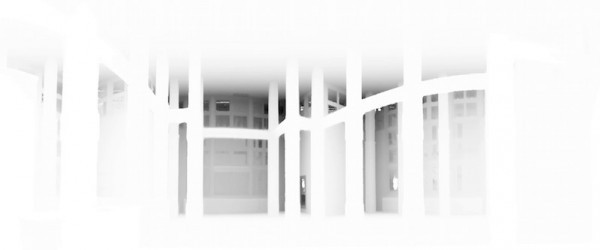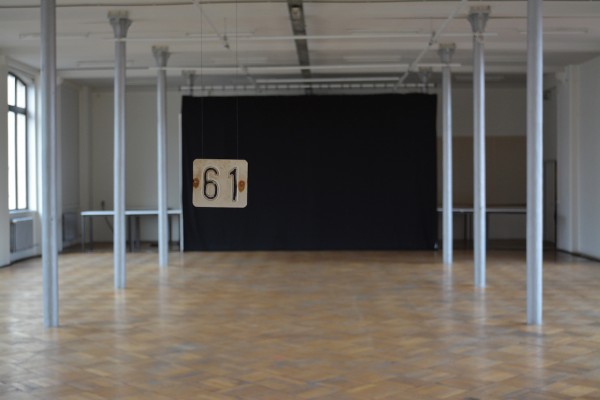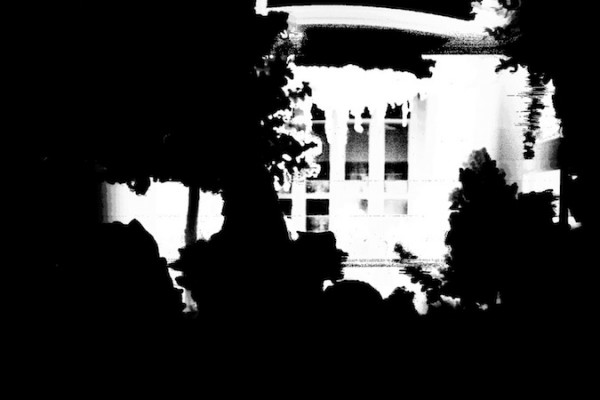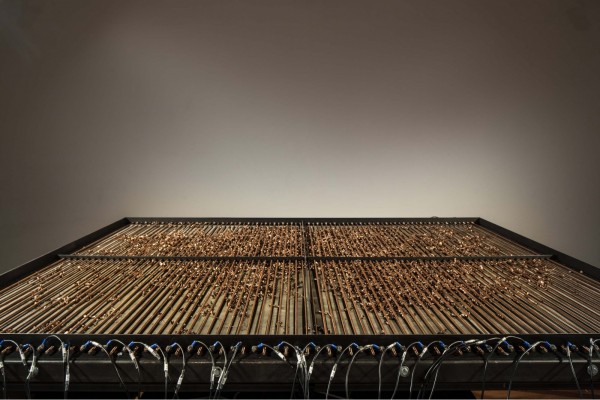The State of Things

Works
Mats Dekock – “Memory Screen” (2015)
"Memory Screen" explores the tension between subjective interpretation and objective perception, between memory and imagination. When reconstructing the past, some details remain concealed or become blurry. Others get a prominent place. The reconstruction of a memory is a mental construction of a newly generated image, that reconnects previous impressions and memories through our imagination.

"Memory Screen" plays with the relation between perception and projection. The installation works like a memory screen, onto which a hacked dia projector shoots impressions of experiences and electrical components are saved. The screen has an electric memory, like the retina that recalls impressions for a while, before they fade out.
The output is the LED, which operates as a sensor of perception and projects what it perceives. The capacitor is the storage organ, which is charged by the electricity it receives from the LED and translates what it sees. LED and capacitor form a whole that sees, interprets, imagines and remembers.
Concept & realisation: Mats Dekock / Production: Werktank / With the support of the Flemish Authorities
Stijn Demeulenaere – “61” (2015)
"61" is the first work out of Stijn's artistic research on the phenomenology of sound, or the phenomenology of listening, and was developed during a residency at Overtoon. The installation researches his own history as a listener. In "61" he is working with the recordings he made in his parental home a couple of years ago. The house itself has disappeared since then.

In those last months of the house, he recorded all the sounds he could get his hands on. "61" works with recordings of room tones - the signature background sounds of a room - and a special surround sound setup, using normal and hyperdirectional speakers. The hyperdirectional speakers are mounted on moving pan/tilt units, thus creating a continuously moving grid of sound. It explores how a house - his house, your house, our house - sounds. Which role does sound play in making us feel at home? What does 'a home' sound like, what does your home sound like? How much is this background sound part of our own history, our own identity? How has it contributed to the person he is today, or the person he will be tomorrow?
Concept & realisation: Stijn Demeulenaere / Recordings: Stijn Demeulenaere, Thomas Demeulenaere
Production: Overtoon / In collaboration with: Kunstenwerkplaats Pianofabriek, STUK kunstencentrum, Cimatics / With the support of the Flemish authorities and the Flemish Community Commission of the Brussels Capital Region
Elias Heuninck – “Lightkeeping” (2015)
Curious about creating a new image quality, Elias Heuninck made a digital camera. A very simple one. Instead of using a complex sensor to capture the whole image in a fraction of a second, it builds up the image pixel by pixel by making one simple measurement at a time. The camera starts at the top left corner and works its way to the bottom right one, just as you are reading this text. To get the information for each position, the camera shoots a short pulse of laser light towards its subject and waits for the light-echo to return. It is then able to find the distance between itself and the object that reflected the light. The collected measurements do not show anything recognisable yet. The data has to be translated first in order to be visible as a greyscale image.

With an exposure time of four days (up to four weeks), it is not the most practical camera around, but it allows to work directly with the building blocks of the picture itself. The resulting images are digital by nature, yet the visual resemblance with prints from the early days of photography is striking. Whereas the conventional camera is a darkroom that captures light, this camera is more like a lighthouse. Similarly, since every point in the image is a distance measurement, the image becomes a map.
Concept & realisation: Elias Heuninck / Voice over: Emi Kodama / Letters : 'The Correspondence of William Henry Fox Talbot' project / Technical assistance: Culture Crew & Vincent Jacobs / Editing coach: Fairuz & Anouk De Clercq
Production : Werktank & Auguste Orts / With the support of the Flemish authorities
Jeroen Uyttendaele - "Vonkveld#3" (2014)
“Vonkveld 3 “(Dutch for spark field 3) is an audiovisual installation in which electricity is the main expressive medium. A table (2m10 by 1m54) filled with copper swarf is systematically electrified and produces a changing field of spark patterns. The field functions as a horizontal screen generating light and sound in a direct and visceral way. The table is made out of a grid of 80 individually controlled rods which run electricity through the copper shavings.

Vonkveld 3 is the third instalment of an extensive research on electricity in a pure form and as an expressive medium. Electricity marked the beginning of the second industrial revolution and remains the main driving force of our current information age. The spark is a symbol for electricity. It is one of the most elementary ways of producing light and sound. The installation reflects on the meaning of communication technology by presenting it in it’s most naked form.
Concept & realisation: Jeroen Uyttendaele
Production: Overtoon / Coproduction: Z33 / With the support of the Flemish authorities
Opening
Thursday November 26 2015
18:30-22:00
Dates
November 27 - December 18 2015
Wed-Sun, 13:00-18:00
Tour of the exhibition guided by the artists
Saturday December 12 2015
15:00 - 17:00
Free entrance!
Group visits
+32-2-410 30 93
info@imal.org
Location: iMAL
quai des Charbonnages 30 Koolmijnenkaai
1080 Brussels
Downloads
An archive : 1999-2010-2019
This page is an archive of the iMAL website that operated between 2010 and 2019. It compiles activities and projects made since 1999.
For our most recent news and activities, please check our new website at https://imal.org
